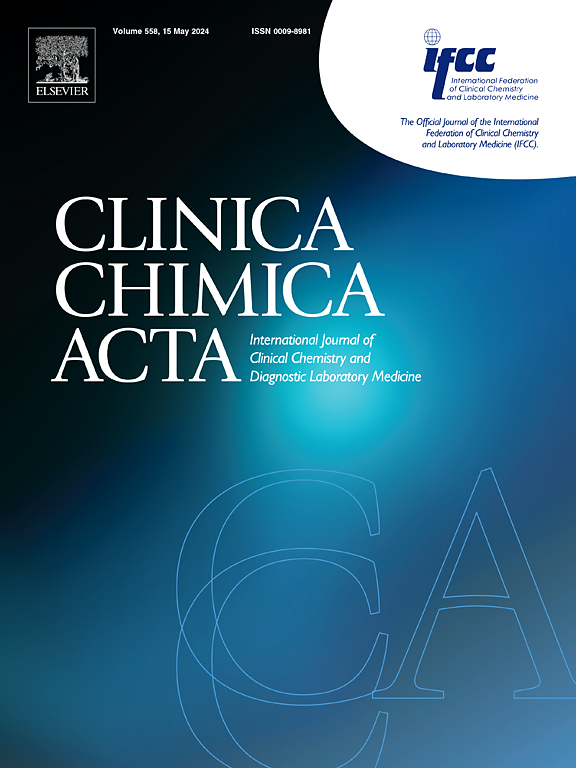Extracellular fluid miRNAs in PCOS
IF 2.9
3区 医学
Q2 MEDICAL LABORATORY TECHNOLOGY
引用次数: 0
Abstract
Polycystic ovary syndrome (PCOS) is a prevalent endocrine condition that impacts both reproductive and metabolic functioning. Despite thorough research, the exact causes of PCOS remain unclear. Recent studies indicate that microRNAs (miRNAs), which are small non-coding RNAs that regulate gene expression, could be crucial for comprehending PCOS. This review article investigates the variations in extracellular fluids miRNAs expression in individuals diagnosed with PCOS and assesses their viability as diagnostic biomarkers, and determines their involvement in the mechanisms underlying the disease. The related reports show that miRNA expression profiles demonstrate notable differences between PCOS patients and healthy subjects. Several miRNAs exhibit dysregulation in essential biological processes such as follicular development, steroidogenesis, insulin signaling, and metabolic pathways. These results imply that miRNAs could lead to hormonal imbalances and metabolic problems linked to PCOS. The variations in miRNA expression noted in patients with PCOS underscore their possible role as biomarkers for the early detection and characterization of the condition. Continued investigation into miRNA-based diagnostic and therapeutic strategies may enhance our comprehension of PCOS. and facilitate the advancement of more precise therapeutic alternatives.
PCOS的细胞外液miRNAs
多囊卵巢综合征(PCOS)是一种影响生殖和代谢功能的常见内分泌疾病。尽管进行了深入的研究,多囊卵巢综合征的确切病因仍不清楚。最近的研究表明,microRNAs (miRNAs)是一种调节基因表达的小非编码rna,可能对PCOS的理解至关重要。这篇综述研究了PCOS患者细胞外液miRNAs表达的变化,评估了它们作为诊断生物标志物的可行性,并确定了它们在PCOS发病机制中的作用。相关报道显示,PCOS患者与健康受试者的miRNA表达谱存在显著差异。一些mirna在基本的生物学过程中表现出失调,如卵泡发育、类固醇生成、胰岛素信号传导和代谢途径。这些结果表明,mirna可能导致与多囊卵巢综合征相关的激素失衡和代谢问题。在多囊卵巢综合征患者中发现的miRNA表达变化强调了它们作为早期发现和表征多囊卵巢综合征的生物标志物的可能作用。继续研究基于mirna的诊断和治疗策略可能会提高我们对PCOS的理解。并促进更精确的治疗替代方案的发展。
本文章由计算机程序翻译,如有差异,请以英文原文为准。
求助全文
约1分钟内获得全文
求助全文
来源期刊

Clinica Chimica Acta
医学-医学实验技术
CiteScore
10.10
自引率
2.00%
发文量
1268
审稿时长
23 days
期刊介绍:
The Official Journal of the International Federation of Clinical Chemistry and Laboratory Medicine (IFCC)
Clinica Chimica Acta is a high-quality journal which publishes original Research Communications in the field of clinical chemistry and laboratory medicine, defined as the diagnostic application of chemistry, biochemistry, immunochemistry, biochemical aspects of hematology, toxicology, and molecular biology to the study of human disease in body fluids and cells.
The objective of the journal is to publish novel information leading to a better understanding of biological mechanisms of human diseases, their prevention, diagnosis, and patient management. Reports of an applied clinical character are also welcome. Papers concerned with normal metabolic processes or with constituents of normal cells or body fluids, such as reports of experimental or clinical studies in animals, are only considered when they are clearly and directly relevant to human disease. Evaluation of commercial products have a low priority for publication, unless they are novel or represent a technological breakthrough. Studies dealing with effects of drugs and natural products and studies dealing with the redox status in various diseases are not within the journal''s scope. Development and evaluation of novel analytical methodologies where applicable to diagnostic clinical chemistry and laboratory medicine, including point-of-care testing, and topics on laboratory management and informatics will also be considered. Studies focused on emerging diagnostic technologies and (big) data analysis procedures including digitalization, mobile Health, and artificial Intelligence applied to Laboratory Medicine are also of interest.
 求助内容:
求助内容: 应助结果提醒方式:
应助结果提醒方式:


